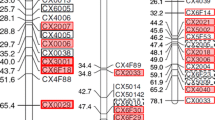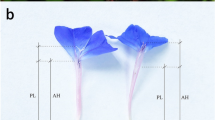Abstract
We examined the effects of pollen selection for rapid pollen-tube growth on progeny vigor. First, we crossed a wild gourd (Cucurbita texana) to a cultivated zucchini (Cucurbita pepo cv ‘Black Beauty’) to produce an F1 and then an F2 generation. Half of the F1 seeds were produced by depositing small loads of C. texana pollen onto the stigmas of C. pepo. These small pollen loads were insufficient to produce a full complement of seeds and, consequently, both the fast- and the slow-growing pollen tubes were permitted to achieve fertilization. An F2 generation was then produced by depositing small loads of F1 pollen onto stigmas of F1 plants. The F2 seeds resulting from two generations of small pollen loads are termed the non-selected line because there was little or no selection for pollen-tube growth rate on these plants. The other half of the F1 and F2 seeds were produced by depositing large pollen loads (>10 000 pollen grains) onto stigmas and then allowing only the first 1% or so of the pollen tubes that entered the ovary to fertilize the ovules. We did this by excising the styles at the ovary at 12–15 h after pollination. The resulting F2 seeds are termed ‘the selected line’ because they were produced by two generations of selection for only the fastest growing pollen tubes. Small pollen loads from the F2plants, both the selected and the non-selected lines, were then deposited onto stigmas of different C. pepo flowers, and the vigor of the resulting seeds was compared under greenhouse and field conditions. The results showed that the seeds fertilized by pollen from the selected line had greater vegetative vigor as seedlings and greater flower and fruit production as mature plants than the seeds fertilized by pollen from the non-selected line. This study demonstrates that selection for fast pollen-tube growth (selection on the microgametophyte) leads to a correlated increase in sporophyte (progeny) vigor.
Similar content being viewed by others
References
Bawa KS, Webb CJ (1984) Flower, fruit and seed abortion in tropical forest trees: Implications for evolution of paternal and maternal reproductive patterns. Am J Bot 71:736–751
Bertin RI (1990) Effects of pollination intensity in Campsis radicans. Am J Bot 77:178–187
Brenner ML (1987) The role of hormones in photosynthate partitioning and seed filling. In: Davies, PJ (ed) Plant hormones and their role in plant growth and development. M. N. Shoff, Minneapolis, MN, pp 474–493
Casper BB (1988) Evidence for selective embryo abortion in Cryptantha flava. Am Nat 132:318–326
Charlesworth B, Charlesworth D (1987) Inbreeding and its evolutionary consequences. Ann Rev Ecol Syst 18:237–268
Charlesworth D (1988) A comment on the evidence for pollen competition in plants and its relationship to progeny fitness. Am Nat 132:298–302
Charlesworth D, Charlesworth B (1992) The effects of selection in the gametophyte stage on mutational load. Evolution 46:703–720
Charlesworth D, Schemske DW, Sork VK (1987) The evolution of plant reproductive characters, sexual vs. natural selection. In: Stearns SC (ed) The evolution of sex and its consequences. Birkhauser Verlag, Basel, pp 317–335
Charnov EL (1979) Simultaneous hermaphroditism and sexual selection. Proc Natl Acad Sci USA 76:2480–2484
Davis LE, Stephenson AG, Winsor JA (1987) Pollen competition improves performance and reproductive output of the common zucchini squash under field conditions. J Am Soc Hortic Sci 112:711–716
Decker-Walters DS (1990) Evidence for multiple domestication of Cucurbita pepo. In: Bates DM, Robinson RW, Jeffrey C (eds) Biology and utilization of the Cucurbitaceae. Cornell University Press, New York, pp 96–101
Decker DS, Wilson HD (1987) Allozyme variation in Cucurbita pepo complex. C. pepo var. ovifera vs. C. texana. Syst Bot 12:263–273
Fingerett ER (1979) Pollen competition in a species of evening primerose, Oenothera organensis Munz. MSc thesis, Washington State University, Pullman, Wash.
Hamrick JL, Godt MJW (1989) Allozyme diversity in plant species. In: Brown AHD, Clegg MT, Kahler AL, Weir BS (eds) Plant population genetics, breeding and genetic resources. Sinauer Associates, Sunderland, Mass., pp 43–63
Johnson CM, Mulcahy DL (1978) Male gametophyte in maize: II Pollen vigor in inbred plants. Theor Appl Genet 51:211–215
Landi P, Frascaroli E, Speranza A (1986) Pollen characteristics of maize (Zea mays L.) inbred lines selected for grain yield. Genet Agric 40:397–404
Lee TD (1984) Patterns of fruit maturation: a gametophytic competition hypothesis. Am Nat 123:427–432
Lee TD (1988) Patterns of fruit and seed production. In: Lovett Doust J, Lovett Doust L (eds) Plant reproductive ecology: patterns and strategies. Oxford University Press, N.Y., pp 179–202
Lee TD, Hartgerinck AP (1986) Pollination intensity, fruit maturation pattern and offspring quality in Cassia fasciculate (Leguminosae). In: Mulcahy DL, Ottaviano EM (eds) Pollen: biology and implications for plant breeding. Elsevier Biomedical Press, New York, pp 417–422
McKenna M, Mulcahy DL (1983) Ecological aspects of gametophytic competition in Dianthus chinensis. In: Mulcahy DL, Ottaviano EM (eds) Pollen: biology and implications for plant breeding. Elsevier Biomedical Press, New York, pp 443–448
Mulcahy DL (1979) The rise of angiosperms: a genecological factor. Science 206:20–23
Mulcahy DL, Mulcahy GB (1975) The influence of gametophytic competition on sporophytic quality in Dianthus chinensis. Theor Appl Genet 46:277–280
Mulcahy DL, Mulcahy GB, Ottaviano E (1975) Sporophytic expression of gametophytic competition in Petunia hybrida. In: Mulcahy DL (ed) Gamete competition in plants and animals. North Holland Publishing Company, Amsterdam, pp 227–232
Mulcahy DL, Mulcahy GB, Ottaviano E (1978) Further evidence that gametophytic selection modifies the genetic quality of the sporophyte. Soc Bot Fr Actual Bot 1–2:57–60
Nakamura RR (1988) Seed abortion and seed size variation within fruits of Phaseolus vulgaris: pollen donor and resource variation effects. Am J Bot 75:1003–1010
Ottaviano EM, Mulcahy DL (1989) Genetics of angiosperm pollen. Adv Genet 26:1–64
Ottaviano EM, Sari-Gorla M, Arenari I (1983) Male gametophytic competition in maize: selection and implications with regard to breeding systems. In: Mulcahy DL, Ottaviano EM (eds) Pollen: biology and implications for plant breeding. Elsevier Biomedical Press, New York, pp 367–374
Ottaviano E, Sari-Gorla M, Villa M (1988) Pollen competitive ability in maize: within population variability and response to selection. Theor Appl Genet 76:601–608
Quesada M, Schlichting CD, Winsor JA, Stephenson AG (1991) Effects of genotype on pollen performance in Cucurbita pepo. Sex Plant Reprod 4:208–214
Quesada M, Winsor JA, Stephenson AG (1993) Effects of pollen competition on progeny performance in a heterozygous cucurbit. Am Nat 142:694–706
Ramstetter J, Mulcahy DL (1988) Consequences of pollen competition for Aureolaria flava seedlings. Bull Ecol Soc Am Suppl 69:269–270
Richardson TE, Stephenson AG (1992) Effects of parentage and size of the pollen load on progeny performance in Campanula americana. Evolution 46:1731–1739
Rocha OJ, Stephenson AG (1991) Effects of nonrandom seed abortion on progeny performance in Phaseolus coccineus L. Evolution 45:1198–1208
SAS Institute (1990) SAS user's guide: statistics. SAS Institute, Cary, N.C.
Schlichting CD, Small L, Stephenson AG, Winsor JA (1990) Pollen loads and progeny vigor: the next generation. Evolution 44:1358–1372
Snow AA (1990) Effects of pollen-load size and number of donors on sporophyte fitness in wild radish (Raphanus raphanistrum). Am Nat 136:742–758
Snow AA, Mazer SJ (1988) Gametophytic selection in Raphanus raphanistrum: a test for heritable variation in pollen competitive ability. Evolution 42:1065–1075
Stearns SC (1987) The selection arena hypothesis. In: Stearns SC (ed) The evolution of sex and its consequences. Birkhauser Verlag, Basel, pp 337–349
Stephenson AG, Winsor JA, Davis LE (1986) Effects of pollen load size on fruit maturation and sporophyte quality in zucchini. In: Mulcahy DL, Ottaviano EM (eds) Biotechnology and ecology of pollen. Springer, Berlin Heidelberg New York, pp 429–431
Stephenson AG, Devlin B, Horton JB (1988a) The effects of seed number and prior fruit dominance on the pattern of fruit production in Cucurbita pepo (zucchini squash). Ann Bot 62:653–661
Stephenson AG, Winsor JA, Schlichting CD (1988b) Evidence for non-random fertilization in the common zucchini, Cucurbita pepo. In: Cresti M, Gori P, Pacini E (eds) Sexual reproduction in higher plants. Springer, Berlin Heidelberg New York, pp 333–338
Stephenson AG, Winsor JA, Schlichting CD, Davis LE (1988c) Pollen competition, non-random fertilization, and progeny fitness: a reply to Charlesworth. Am Nat 132:303–308
Stephenson AG, Quesada MR, Schlichting CD, Winsor JA (1995) Consequences of variation in pollen load size. In: Hoch PC, Stephenson AG (eds) Experimental and molecular approaches to plant systematics. Monogr Syst Bot 53:233–244
Tanksley S, Zamir D, Rick CM (1981) Evidence for the extensive overlap of sporophytic and gametophytic gene expression in Lycopersicon esculentum. Science 213:453–455
Walsh NE, Charlesworth, D (1992) Evolutionary interpretations of differences in pollen-tube growth rates. Q Rev Biol 67:19–36
Waser NM, Price MV, Montalvo AM, Gray RN (1987) Female choice in a perennial herbaceous wildflower. Delphinium nelsonii. Evol Trends Plants 1:29–33
Westoby M, Rice B (1982) Evolution of the seed plants and inclusive fitness of plant tisues. Evolution 36:713–724
Willing RP, Mascarenhas JP (1984) Analysis of the complexity and diversity of mRNAs from pollen and shoots of Tradescantia. Plant Physiol 75:865–868
Willing RP, Bashe B, Mascarenhas JP (1988) Analysis of quantity and diversity of messenger RNAs from pollen and shoots of Zea mays. Theor Appl Genet 75:751–753
Winsor JA, Davis LE, Stephenson AG (1987) The relationship between pollen load and fruit maturation and the effect of pollen load on offspring vigor in Cucurbita pepo. Am Nat 129:643–656
Young HJ, Stanton ML (1990) Influence of environmental quality on pollen competitive ability in wild radish. Science 248:1631–1633
Author information
Authors and Affiliations
Additional information
Communicated by P. L. Pfahler
Rights and permissions
About this article
Cite this article
Quesada, M., Winsor, J.A. & Stephenson, A.G. Effects of pollen selection on progeny vigor in a Cucurbita pepo x C. texana hybrid. Theoret. Appl. Genetics 92, 885–890 (1996). https://doi.org/10.1007/BF00221902
Received:
Accepted:
Issue Date:
DOI: https://doi.org/10.1007/BF00221902




